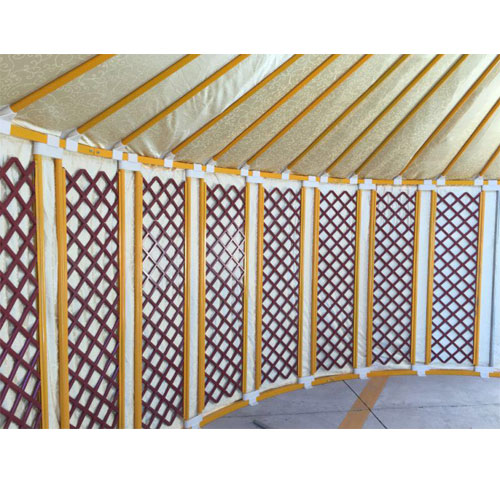As I’ve been doing research on tiny home living, I stumbled across an article talking about yurts as a tiny home dwelling and I started to wonder how easy it is to build a yurt. The first thing that came to my mind when I read the word yurt was tent, and the second was nomad, or mobile.
As I started down that rabbit hole of yurts, I learned a lot about yurts and the process of setting one up to see if it was a feasible option for individuals. Most yurts used as a primary dwelling are actually set up to be more permanent and stable.
How Long Will Yurt Building Take?

A DIY yurt will take between 1 to 5 days to construct, if you’re following a plan and have all the materials on hand. It is possible to set up a yurt by yourself, but two or more people are recommended.
At Off Grid Dwellings, our yurts take between 4 to 10 hours to set up, depending on which yurt kit you purchased, and can be set up easily with two people.
Setting up a yurt kit will obviously go quicker than a DIY yurt as everything is already custom made to fit, similar to a tent that you would find in a sporting goods store.
Where a custom-built yurt would require some significant time and tools, the yurt kits only require a hammer, a drill (just in case), a ladder, and cutting shears for installing windows.
30” yurts and bigger will require scaffolding and a crane to build, especially for the ventilator top.
What Is The Difference Between a Tent And a Yurt?
Yurts, or Gers as they are known in Mongolian, come from Central Asia and have been around for at least three thousand years. The Greek historian, Herodotus was the first westerner to write a description of a yurt.
Yurts are made up of a wooden lattice structure for the walls which support the roof poles. They are also typically made from canvas or other materials that are stronger than your typical nylon or polyester camping tent.
Yurts are also sturdier than a tent and can withstand wind and other elements better than a tent can.

How Much Will it Cost to Build a Yurt?

Not counting a platform and infrastructure, a yurt will cost $20,000 to $30,000 for a DIY project.
Our yurt kits at Off Grid Dwelling cost $4,600 to $36,950.
Once you have your yurt the next step would be to construct a platform for it. This will help secure it permanently and will also give you a solid and even floor.
The cost for the platform will depend on the materials that you use, but plan on around $2,000 to $6,000 for total cost of your platform.
Depending on where you are placing your yurt, you may have to get permits which will be additional cost and varies from city to city. Check with your local city or county for rules and regulations about the codes and laws regarding yurts.
Is a Yurt Considered a Permanent Structure?
It depends on the local building codes as to whether a yurt is considered a permanent structure. A lot of areas are not zoned yet for this alternate living style and will classify the yurt as a temporary dwelling. Again, it is best to check with your local building officials.
Can You Live in a Yurt in The Winter?
Yurts originated in Mongolia, where winter temperatures can get as low as -40 degrees Fahrenheit and snow piles up. With a few additions to your yurt it’s possible to live in it through the winter and year-round.
A stove is the biggest investment that you will want to make if you plan on using your yurt through the winter. A wood stove not only will heat the yurt but is also great to have for cooking and baking.
Some people use that as an excuse to bake and cook more in the winters as not only is it healthier, but when they’re done baking, they’ll leave the stove door open to heat the yurt.


Insulating the yurt is an absolute must. Insulating the walls and roof with foil-faced insulation (like Reflectix) will retain the heat through the winter.
It’s also a good idea to insulate your platform as well, especially if you have it elevated off the ground as this allows for more air flow underneath the platform and can make the floor very chilly during the winters.
There are many ways to insulate the platform and the method you choose depends on region and climate.
How Long do Yurts Last?
The frame of the yurt, whether wood or metal, will last indefinitely. The canvas or fabric cover will usually last eight to fifteen years, depending on UV rays and climate in your area. It’s also not uncommon to get twenty years or more out of your covering.
You can extend that life by occasionally washing the walls and roof. It’s best to use a mild soap and water.
Pressure washing is never recommended as it can cause serious damage to the covering and will require replacing sooner rather than later.

In harsh climates, it is recommended recoating the surface of wooden doors about every two to five years with wood stain or polyurethane to protect it from the weather and extend the life of the door.
Do You Need Permits to Live in a Yurt?

Yurts are a very versatile structure that have a wide range of applications. Factors like the size and use of the yurt, as well as the location of the site will help determine if you need a permit and the type of permit required.
Because building codes are different from area to area, requirements are going to be different, and yurts don’t always fit neatly into one category.
Often a yurt is classified as a studio, recreational structure, or an auxiliary building.
Your yurt may have to meet certain requirements depending on your region, such as snow load, seismic rating, wind speed, and fire safety. Other requirements such as egress and occupancy are dependent upon the use of the yurt and will also vary from city to city.
The best thing to do is to check with your local planning or building official, show them the yurt ratings and what your intended use of the yurt will be. They will be able to give you the required information on what’s required for your area.
The Bottom Line
Whether you buy a kit or DIY it, building a yurt is easier than building a conventional house. You still have to follow all the local city and county codes and regulations, but as to materials and man power you can’t go wrong with this choice of alternative living!



